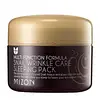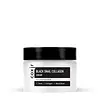What's inside
What's inside
 Key Ingredients
Key Ingredients

 Benefits
Benefits

 Concerns
Concerns

 Ingredients Side-by-side
Ingredients Side-by-side

Snail Secretion Filtrate
Skin ConditioningGlycerin
HumectantWater
Skin ConditioningCetyl Ethylhexanoate
EmollientButylene Glycol
HumectantDipropylene Glycol
HumectantCetearyl Alcohol
EmollientCyclopentasiloxane
EmollientCitrus Limon Peel Oil
MaskingOlea Europaea Fruit Oil
MaskingCitrus Aurantium Dulcis Oil
MaskingCitrus Aurantium Bergamia Fruit Oil
MaskingCedrus Atlantica Bark Oil
MaskingCitrus Aurantium Dulcis Fruit Extract
MaskingCitrus Grandis Fruit Extract
AstringentPinus Sylvestris Leaf Oil
MaskingLavandula Angustifolia Extract
Skin ConditioningSalvia Sclarea Oil
MaskingAniba Rosodora Wood Oil
AstringentEucalyptus Globulus Leaf Oil
PerfumingCitrus Aurantifolia Oil
CleansingCoriandrum Sativum Fruit Oil
MaskingSalvia Officinalis Oil
MaskingArtemisia Absinthium Extract
Skin ConditioningChamomilla Recutita Flower Extract
MaskingButyrospermum Parkii Butter
Skin ConditioningCaulerpa Lentillifera Extract
Sea Water
HumectantTremella Fuciformis Extract
HumectantSaccharomyces Ferment Filtrate
HumectantVanilla Planifolia Fruit Extract
Skin ConditioningSantalum Album Oil
MaskingHoney Extract
HumectantAureobasidium Pullulans Ferment
Skin ConditioningFomes Officinalis Extract
Skin ProtectingAcacia Seyal Gum Extract
HumectantGlycine Max Seed Extract
Skin ConditioningDioscorea Japonica Root Extract
Skin ConditioningGlyceryl Stearate
EmollientHydrogenated Polydecene
EmollientCyclohexasiloxane
EmollientSodium Polyacrylate
AbsorbentSorbitan Stearate
EmulsifyingPEG-100 Stearate
Magnesium Aluminum Silicate
AbsorbentPolysorbate 80
EmulsifyingCaprylyl Glycol
EmollientDimethicone
EmollientAminomethyl Propanol
BufferingAdenosine
Skin ConditioningPropylene Glycol
HumectantPentylene Glycol
Skin ConditioningEthyl Hexanediol
SolventGlyceryl Caprylate
Emollient1,2-Hexanediol
Skin ConditioningEthylhexylglycerin
Skin ConditioningSh-Octapeptide-4
AntioxidantSh-Decapeptide-7
AntioxidantSh-Pentapeptide-19
Skin ConditioningSh-Oligopeptide-9
HumectantCarbomer
Emulsion StabilisingXanthan Gum
EmulsifyingDisodium EDTA
Phenoxyethanol
PreservativePotassium Sorbate
PreservativeSnail Secretion Filtrate, Glycerin, Water, Cetyl Ethylhexanoate, Butylene Glycol, Dipropylene Glycol, Cetearyl Alcohol, Cyclopentasiloxane, Citrus Limon Peel Oil, Olea Europaea Fruit Oil, Citrus Aurantium Dulcis Oil, Citrus Aurantium Bergamia Fruit Oil, Cedrus Atlantica Bark Oil, Citrus Aurantium Dulcis Fruit Extract, Citrus Grandis Fruit Extract, Pinus Sylvestris Leaf Oil, Lavandula Angustifolia Extract, Salvia Sclarea Oil, Aniba Rosodora Wood Oil, Eucalyptus Globulus Leaf Oil, Citrus Aurantifolia Oil, Coriandrum Sativum Fruit Oil, Salvia Officinalis Oil, Artemisia Absinthium Extract, Chamomilla Recutita Flower Extract, Butyrospermum Parkii Butter, Caulerpa Lentillifera Extract, Sea Water, Tremella Fuciformis Extract, Saccharomyces Ferment Filtrate, Vanilla Planifolia Fruit Extract, Santalum Album Oil, Honey Extract, Aureobasidium Pullulans Ferment, Fomes Officinalis Extract, Acacia Seyal Gum Extract, Glycine Max Seed Extract, Dioscorea Japonica Root Extract, Glyceryl Stearate, Hydrogenated Polydecene, Cyclohexasiloxane, Sodium Polyacrylate, Sorbitan Stearate, PEG-100 Stearate, Magnesium Aluminum Silicate, Polysorbate 80, Caprylyl Glycol, Dimethicone, Aminomethyl Propanol, Adenosine, Propylene Glycol, Pentylene Glycol, Ethyl Hexanediol, Glyceryl Caprylate, 1,2-Hexanediol, Ethylhexylglycerin, Sh-Octapeptide-4, Sh-Decapeptide-7, Sh-Pentapeptide-19, Sh-Oligopeptide-9, Carbomer, Xanthan Gum, Disodium EDTA, Phenoxyethanol, Potassium Sorbate
Water
Skin ConditioningAloe Barbadensis Leaf Extract
EmollientButylene Glycol
HumectantDipropylene Glycol
HumectantPropylene Glycol
HumectantCaprylic/Capric Triglyceride
MaskingOlivoyl Hydrolyzed Wheat Protein
CleansingCetearyl Alcohol
EmollientGlyceryl Oleate
EmollientGlyceryl Stearate
EmollientGlycereth-26
HumectantOrbignya Oleifera Seed Oil
EmollientHydrogenated Polydecene
EmollientHydroxyethylcellulose
Emulsion StabilisingBetaine
HumectantDimethicone
EmollientTriethanolamine
BufferingPEG-90m
Emulsion StabilisingRosa Canina Fruit Oil
EmollientPanax Ginseng Root Extract
EmollientCamellia Sinensis Leaf Extract
AntimicrobialHoney
HumectantRosa Multiflora Fruit Extract
MaskingGardenia Florida Fruit Extract
Skin ConditioningScutellaria Baicalensis Root Extract
AstringentLigustrum Japonicum Fruit Extract
Skin ConditioningAcanthopanax Senticosus Root Extract
Skin ConditioningPunica Granatum Fruit Extract
AntioxidantCarthamus Tinctorius Flower Extract
Skin ConditioningGlycine Soja Seed Extract
Skin ConditioningSesamum Indicum Seed Extract
Skin ConditioningOryza Sativa Extract
AbsorbentTheobroma Cacao Extract
Skin ConditioningPanax Ginseng Berry Extract
Skin ConditioningSnail Secretion Filtrate
Skin ConditioningHydrolyzed Collagen
EmollientCopper Tripeptide-1
Skin ConditioningAdenosine
Skin ConditioningLeontopodium Alpinum Extract
Skin ConditioningThymus Vulgaris Extract
PerfumingMalva Sylvestris Flower Extract
Skin ConditioningBambusa Vulgaris Leaf/Stem Extract
HumectantCarbomer
Emulsion StabilisingPhenoxyethanol
PreservativeEthylhexylglycerin
Skin ConditioningParfum
MaskingWater, Aloe Barbadensis Leaf Extract, Butylene Glycol, Dipropylene Glycol, Propylene Glycol, Caprylic/Capric Triglyceride, Olivoyl Hydrolyzed Wheat Protein, Cetearyl Alcohol, Glyceryl Oleate, Glyceryl Stearate, Glycereth-26, Orbignya Oleifera Seed Oil, Hydrogenated Polydecene, Hydroxyethylcellulose, Betaine, Dimethicone, Triethanolamine, PEG-90m, Rosa Canina Fruit Oil, Panax Ginseng Root Extract, Camellia Sinensis Leaf Extract, Honey, Rosa Multiflora Fruit Extract, Gardenia Florida Fruit Extract, Scutellaria Baicalensis Root Extract, Ligustrum Japonicum Fruit Extract, Acanthopanax Senticosus Root Extract, Punica Granatum Fruit Extract, Carthamus Tinctorius Flower Extract, Glycine Soja Seed Extract, Sesamum Indicum Seed Extract, Oryza Sativa Extract, Theobroma Cacao Extract, Panax Ginseng Berry Extract, Snail Secretion Filtrate, Hydrolyzed Collagen, Copper Tripeptide-1, Adenosine, Leontopodium Alpinum Extract, Thymus Vulgaris Extract, Malva Sylvestris Flower Extract, Bambusa Vulgaris Leaf/Stem Extract, Carbomer, Phenoxyethanol, Ethylhexylglycerin, Parfum
Ingredients Explained
These ingredients are found in both products.
Ingredients higher up in an ingredient list are typically present in a larger amount.
Adenosine is in every living organism. It is one of four components in nucleic acids that helps store our DNA.
Adenosine has many benefits when used. These benefits include hydrating the skin, smoothing skin, and reducing wrinkles. Once applied, adenosine increases collagen production. It also helps with improving firmness and tissue repair.
Studies have found adenosine may also help with wound healing.
In skincare products, Adenosine is usually derived from yeast.
Learn more about AdenosineButylene Glycol (or BG) is used within cosmetic products for a few different reasons:
Overall, Butylene Glycol is a safe and well-rounded ingredient that works well with other ingredients.
Though this ingredient works well with most skin types, some people with sensitive skin may experience a reaction such as allergic rashes, closed comedones, or itchiness.
Learn more about Butylene GlycolCarbomer is a polymer of acrylic acid. Its main role is to create a gel consistency.
A high amount of carbomer can cause pilling or balling up of products. Don't worry, most products contain 1% or less of carbomer.
Cetearyl alcohol is a mixture of two fatty alcohols: cetyl alcohol and stearyl alcohol. It is mainly used as an emulsifier. Emulsifiers help prevent the separation of oils and products. Due to its composition, it can also be used to thicken a product or help create foam.
Cetearyl alcohol is an emollient. Emollients help soothe and hydrate the skin by trapping moisture.
Studies show Cetearyl alcohol is non-toxic and non-irritating. The FDA allows products labeled "alcohol-free" to have fatty alcohols.
This ingredient is usually derived from plant oils such as palm, vegetable, or coconut oils. There is debate on whether this ingredient will cause acne.
Due to the fatty acid base, this ingredient may not be Malassezia folliculitis safe.
Learn more about Cetearyl AlcoholDimethicone is a type of synthetic silicone created from natural materials such as quartz.
What it does:
Dimethicone comes in different viscosities:
Depending on the viscosity, dimethicone has different properties.
Ingredients lists don't always show which type is used, so we recommend reaching out to the brand if you have questions about the viscosity.
This ingredient is unlikely to cause irritation because it does not get absorbed into skin. However, people with silicone allergies should be careful about using this ingredient.
Note: Dimethicone may contribute to pilling. This is because it is not oil or water soluble, so pilling may occur when layered with products. When mixed with heavy oils in a formula, the outcome is also quite greasy.
Learn more about DimethiconeDipropylene Glycol is a synthetically created humectant, stabilizer, and solvent.
This ingredient helps:
Dipropylene glycol is technically an alcohol, but it belongs to the glycol family (often considered part of the ‘good’ alcohols). This means it is hydrating and gentle on skin unlike drying solvent alcohols like denatured alcohol.
As a masking agent, Dipropylene Glycol can be used to cover the smell of other ingredients. However, it does not have a scent.
Studies show Dipropylene Glycol is considered safe to use in skincare.
Learn more about Dipropylene GlycolEthylhexylglycerin (we can't pronounce this either) is commonly used as a preservative and skin softener. It is derived from glyceryl.
You might see Ethylhexylglycerin often paired with other preservatives such as phenoxyethanol. Ethylhexylglycerin has been found to increase the effectiveness of these other preservatives.
Glyceryl Stearate is a mix of glycerin and stearic acid.
It is used to stabilize the mixing of water and oil ingredients. By preventing these ingredients from separating, it can help elongate shelf life. It can also help thicken the product's texture.
As an emollient, it helps soften skin and supports barrier-replenishing ingredients.
In cosmetics, Glyceryl Stearate is often made from vegetable oils or synthetically produced.
This ingredient may not be fungal-acne safe
Fun fact: The human body also creates Glyceryl Stearate naturally.
Learn more about Glyceryl StearateHydrogenated Polydecene is an emollient. It creates a non-occlusive film on the skin that offers extra protection for your skin barrier.
The texture of Hydrogenated Polydecene ranges from light and silky to rich.
Hydrogenated Polydecene is the end compound of controlled hydrogenation of Polydecene.
Learn more about Hydrogenated PolydecenePhenoxyethanol is a preservative that has germicide, antimicrobial, and aromatic properties. Studies show that phenoxyethanol can prevent microbial growth. By itself, it has a scent that is similar to that of a rose.
It's often used in formulations along with Caprylyl Glycol to preserve the shelf life of products.
Propylene Glycol is an odorless, colorless liquid. As a humectant, it helps skin retain moisture. It also aids in delivering active ingredients.
Another role of this ingredient is preventing a product from melting or freezing. Propylene glycol also adds antimicrobrial properties to a product, elongating product lifespan.
This ingredient is considered an organic alcohol and commonly added into both cosmetics and foods.
Those with sensitive skin or conditions may develop a rash when using this ingredient.
Learn more about Propylene GlycolSnail Secretion Filtrate is the excretion from snails. It is an effective moisturizer and promotes collagen production.
A popular nickname for this ingredient is 'Snail Mucin'.
Snail mucin has numerous skin benefits:
On top of this, Snail Secretion Filtrate contains a variety of vitamins and minerals. These include copper peptides, Vitamin A, and vitamin E. Vitamins A and E are antioxidants. Antioxidants help fight free-radicals that damage skin cells.
Being cruelty-free means a brand does not experiment on animals.
If you're worried about the well-being of the snails, we recommend looking more into the company of the product. Many brands have developed humane methods to collect snail mucin.
There is much debate on this subject. On one hand, this ingredient comes from an animal. On the other hand, many will argue the ingredient is naturally secreted (like a natural by-product) and therefore vegan. If you have reservations, you can look into Galactomyces Ferment Filtrate or Centella Asiatica Extract as alternatives.
Learn more about Snail Secretion FiltrateWater. It's the most common cosmetic ingredient of all. You'll usually see it at the top of ingredient lists, meaning that it makes up the largest part of the product.
So why is it so popular? Water most often acts as a solvent - this means that it helps dissolve other ingredients into the formulation.
You'll also recognize water as that liquid we all need to stay alive. If you see this, drink a glass of water. Stay hydrated!
Learn more about Water